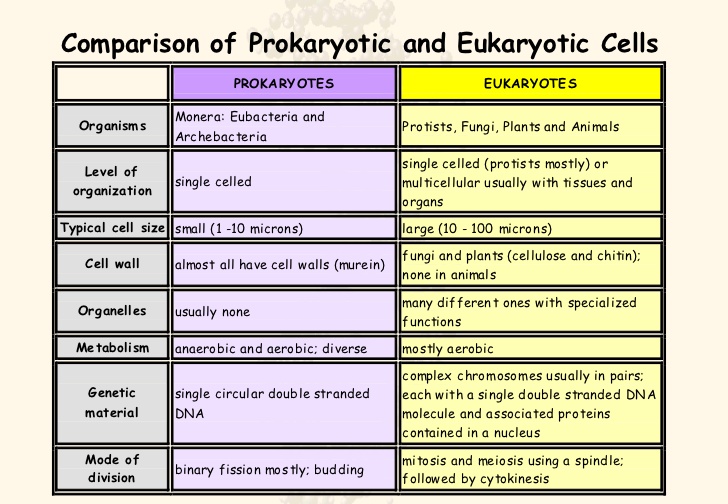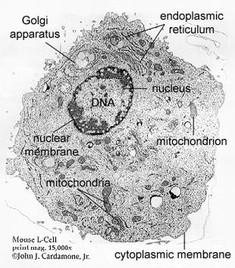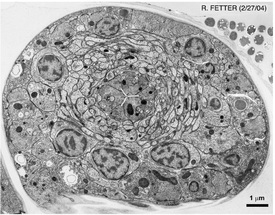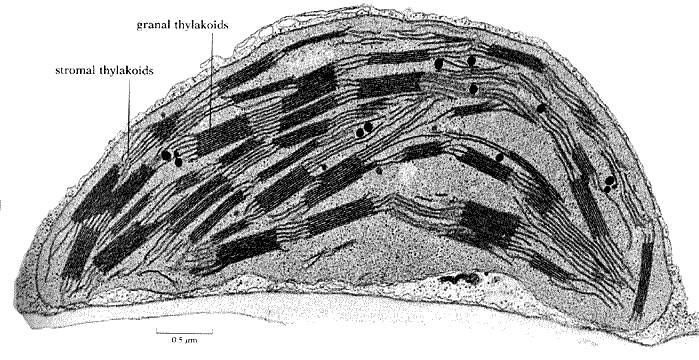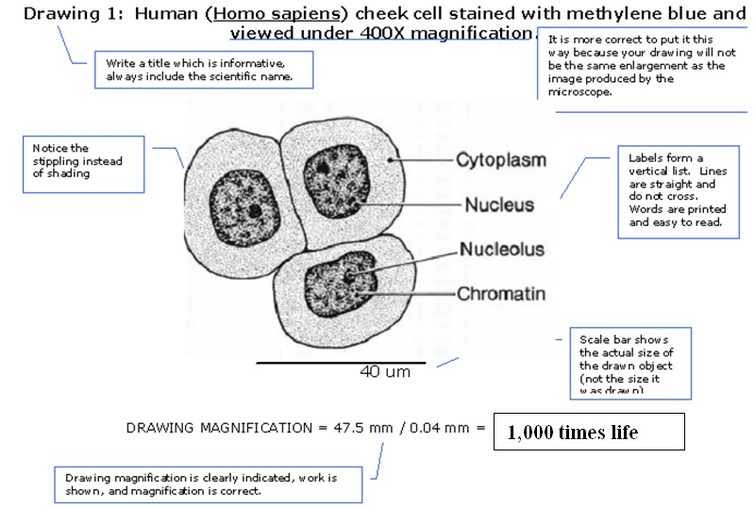topic 1.2 ultra-structure of cells
 image from sites.sinauer.com
image from sites.sinauer.com
In Ultra-Structure of Cells students learn that all living things are made of cells, and cells are the smallest units that can be alive. Life on Earth is classified into five kingdoms, and they each have their own characteristic kind of cell. However the biggest division is between the cells of the prokaryote kingdom (the bacteria) and those of the other four kingdoms (animals, plants, fungi and protoctista), which are all eukaryotic cells. Prokaryotic cells are smaller and simpler than eukaryotic cells, and do not have a nucleus.
Prokaryote = "before carrier bag" i.e. without a nucleus
Eukaryote = "good carrier bag" i.e. with a nucleus
The close detail of a cell, with all organelles visible, that can be seen by using an electron microscope is refered to as the ultra-structure.
The unit is planned to take 3 school days.
Prokaryote = "before carrier bag" i.e. without a nucleus
Eukaryote = "good carrier bag" i.e. with a nucleus
The close detail of a cell, with all organelles visible, that can be seen by using an electron microscope is refered to as the ultra-structure.
The unit is planned to take 3 school days.
Essential Ideas
- Eukaryotes have a much more complex cell structure than prokaryotes.
Nature of Science
- Developments in scientific research follow improvements in apparatus—the invention of electron microscopes led to greater understanding of cell structure.
- With reference to a specific example, explain how an improvement in apparatus allowed for greater understanding of cell structure
- With reference to a specific example, explain how an improvement in apparatus allowed for greater understanding of cell structure
Understanding:
1.2.U.1 Prokaryotes have a simple cell structure without compartmentalisation
- Outline the major differences between prokaryotic and eukaryotic cells.
- List the functions of the following structures of a prokaryotic cell: cell membrane, nucleoid, plasmid, cytoplasm, ribosome, cell wall, pili, capsule, flagella- Define extracellular.
- Contrast the size of eukaryotic and prokaryotic ribosomes
Prokaryotes are organisms whose cells lack a nucleus ('pro' = before ; 'karyon' = nucleus)
They belong to the kingdom Monera and have been further classified into two distinct domains:
Archaebacteria – found in extreme environments like high temperatures, salt concentrations or pH (i.e. extremophiles)
Eubacteria – traditional bacteria including most known pathogenic forms (e.g. E. coli, S. aureus, etc.)
Characteristics of Prokaryotes
Features of Prokaryotes
Cell wall – rigid outer covering made of peptidoglycan; maintains shape and prevents bursting (lysis)
Slime capsule – a thick polysaccharide layer used for protection against dessication (drying out) and phagocytosis
Flagella – Long, slender projections containing a motor protein that enables movement (singular: flagellum)
Pili – Hair-like extensions that enable adherence to surfaces (attachment pili) or mediate bacterial conjugation (sex pili)
Cell membrane – Semi-permeable and selective barrier surrounding the cell
Cytoplasm – internal fluid component of the cell
Nucleoid – region of the cytoplasm where the DNA is located (DNA strand is circular and called a genophore)
Plasmids – autonomous circular DNA molecules that may be transferred between bacteria (horizontal gene transfer)
Ribosomes – complexes of RNA and protein that are responsible for polypeptide synthesis (prokaryote ribosome = 70S)
They belong to the kingdom Monera and have been further classified into two distinct domains:
Archaebacteria – found in extreme environments like high temperatures, salt concentrations or pH (i.e. extremophiles)
Eubacteria – traditional bacteria including most known pathogenic forms (e.g. E. coli, S. aureus, etc.)
Characteristics of Prokaryotes
- Prokaryotes are the single-celled organisms and much smaller than eukaryotic cells.
- The size of most prokaryotes is between 1 µm and 10 µm, but can vary in size from 0.2 µm to 750 µm.
- The prokaryotes are divided into two domains: the bacteria, unicellular microorganisms that have wide range of shapes and ubiquitous in habitat and the archaea, single-celled prokaryotic microorganisms similar to bacteria but possess some genes and several metabolic pathways that are closely related to those of eukaryotes.
- Exists in different shapes like, coccus, bacillus, spirillum, coccobacillus, and spirochete. While some of the prokaryotes are pleomorphic i.e. do not possess constant shape and some exists as aggregate communities.
Features of Prokaryotes
Cell wall – rigid outer covering made of peptidoglycan; maintains shape and prevents bursting (lysis)
Slime capsule – a thick polysaccharide layer used for protection against dessication (drying out) and phagocytosis
Flagella – Long, slender projections containing a motor protein that enables movement (singular: flagellum)
Pili – Hair-like extensions that enable adherence to surfaces (attachment pili) or mediate bacterial conjugation (sex pili)
Cell membrane – Semi-permeable and selective barrier surrounding the cell
Cytoplasm – internal fluid component of the cell
Nucleoid – region of the cytoplasm where the DNA is located (DNA strand is circular and called a genophore)
Plasmids – autonomous circular DNA molecules that may be transferred between bacteria (horizontal gene transfer)
Ribosomes – complexes of RNA and protein that are responsible for polypeptide synthesis (prokaryote ribosome = 70S)
1.2.U.2 Eukaryotes have a compartmentalised cell structure (Oxford Biology Course Companion page 20).
- State the meaning and advantages of eukaryotic cells being “compartmentalized.”
Eukaryotes are organisms whose cells contain a nucleus (‘eu’ = good / true ; ‘karyon’ = nucleus)
They have a more complex structure and are believed to have evolved from prokaryotic cells (via endosymbiosis)
Prokaryotic cells are fundamentally different in their internal organization from eukaryotic cells. Notably, prokaryotic cells lack a nucleus and membranous organelles.The nucleus is bounded by the nuclear envelope, a double membrane with many nuclear pores through which material enters and leaves.
Eukaryotes can be divided into four distinct kingdoms:
They have a more complex structure and are believed to have evolved from prokaryotic cells (via endosymbiosis)
Prokaryotic cells are fundamentally different in their internal organization from eukaryotic cells. Notably, prokaryotic cells lack a nucleus and membranous organelles.The nucleus is bounded by the nuclear envelope, a double membrane with many nuclear pores through which material enters and leaves.
Eukaryotes can be divided into four distinct kingdoms:
- Protista – unicellular organisms; or multicellular organisms without specialised tissue
- Fungi – have a cell wall made of chitin and obtain nutrition via heterotrophic absorption
- Plantae – have a cell wall made of cellulose and obtain nutrition autotrophically (via photosynthesis)
- Animalia – no cell wall and obtain nutrition via heterotrophic ingestion
1.2.U3 Prokaryotes divide by binary fission. (Oxford Biology Course Companion page 19).
- Define asexual reproduction.
- Outline the four steps of binary fission.
Prokaryotic cells divide by binary fission. This involves the replication of their DNA and elongation of the cell such to the point that it will partition or divide into two cells. ... Binary fission is a form of asexual reproduction and this means that the two cells produced are genetically identical to the original cell.
1.2.U.4 Electron microscopes have a much higher resolution than light microscopes
- Define resolution.
- Compare the maximum resolutions of a light microscope with those of an electron microscope.
- List three example structures that are visible with electron microscopes but not with a light microscope

The electron microscope is a type of microscope that uses a beam of electrons to create an image of the specimen. It is capable of much higher magnifications and has a greater resolving power than a light microscope, allowing it to see much smaller objects in finer detail. They are large, expensive pieces of equipment, generally standing alone in a small, specially designed room and requiring trained personnel to operate them.
Transmission electron microscopes (TEM) generate high resolution cross-sections of objects
Scanning electron microscopes (SEM) display enhanced depth to map the surface of objects in 3D
Transmission electron microscopes (TEM) generate high resolution cross-sections of objects
Scanning electron microscopes (SEM) display enhanced depth to map the surface of objects in 3D
Applications:
1.2.A.1 Structure and function of organelles within exocrine gland cells of the pancreas and within palisade mesophyll cells of the leaf
- State the function of an exocrine gland cell.
- Describe the function of the following structures in an exocrine gland cell: plasma membrane, nucleus, mitochondria, Golgi apparatus, lysosomes, vesicles and endoplasmic reticulum
- State the function of a palisade mesophyll cell.
- Describe the function of the following structures in a palisade mesophyll cell: cell wall, plasma membrane, chloroplasts, vacuole, nucleus, and mitochondria.
Exocrine Gland Cells of the Pancreas
Palisade Mesophyll cells carry out most of the photosynthesis in the leaf.
Universal Organelles
Organelles of Eukaryotics
Nucleus - a membrane bound structure that contains the cell's hereditary (DNA) information and controls the cell's growth and reproduction. It is commonly the most prominent organelle in the cell.
Mitochondria - as the cell's power producers, mitochondria convert energy into forms that are usable by the cell. They are the sites of cellular respiration which ultimately generates fuel for the cell's activities. Mitochondria are also involved in other cell processes such as cell division and growth, as well as cell death.
Endoplasmic Reticulum - extensive network of membranes composed of both regions with ribosomes (rough ER) and regions without ribosomes (smooth ER). This organelle manufactures membranes, secretory proteins, carbohydrates, lipids, and hormones.
Golgi complex - also called the Golgi apparatus, this structure is responsible for manufacturing, warehousing, and shipping certain cellular products, particularly those from the endoplasmic reticulum (ER).
Peroxisomes - Like lysosomes, peroxisomes are bound by a membrane and contain enzymes. Peroxisomes help to detoxify alcohol, form bile acid, and break down fats.
Vacuole - these fluid-filled, enclosed structures are found most commonly in plant cells and fungi. Vacuoles are responsible for a wide variety of important functions in a cell including nutrient storage, detoxification, and waste exportation.
Centrioles - these cylindrical structures are found in animal cells, but not plant cells. Centrioles help to organize the assembly of microtubules during cell division.
Cilia and Flagella - cilia and flagella are protrusions from some cells that aid in cellular locomotion. They are formed from specialized groupings of microtubules called basal bodies
Animals Only
Lysosome - membranous sacs filled with hydrolytic enzymes that will breakdown / hydrolysis of macromolecules (presence in plant cells is unsure)
Plants Only
Chloroplast - this chlorophyll containing plastid is found in plant cells, but not animal cells. Chloroplasts absorb the sun's light energy for photosynthesis.
Cell Wall - this rigid outer wall is positioned next to the cell membrane in most plant cells. Not found in animal cells, the cell wall helps to provide support and protection for the cell.
- These are animal cells that are specialized to secrete large quantities of digestive enzymes.
- They will have all the organelles of an animal cell but will have many ribosomes and rough ER to create the enzymes which are proteins and transport them outside the cell.
- They have many mitochondria to supply the ATP needed for these processes.
- An organelle is a tiny cellular structure that performs specific functions within a cell. Organelles are are embedded within the cytoplasm of eukaryotic and prokaryotic cells. In the more complex eukaryotic cells, organelles are often enclosed by their own membrane
Palisade Mesophyll cells carry out most of the photosynthesis in the leaf.
- They have many chloroplasts to allow the cell to carry out the maximum levels of photosynthesis.
- The cells are surrounded by a cell wall to hold the shape of and protect the cell and a plasma membrane to allow substances in and out of the cell.
- They also have mitochondria which are membrane-bound organelles that carry out aerobic cellular respiration to create ATP.
- They have vacuoles which are a large cavity in the middle of the cell that stores water and dissolved substances, e.g. sugars and metabolic by-products
- They are basically plant cells with many chloroplasts.
Universal Organelles
- Ribosomes - these organelles consist of RNA and proteins and are responsible for protein production. Ribosomes are found suspended in the cytosol or bound to the endoplasmic reticulum.
- Cytoskeleton - these structures are filamentous scaffolding within the cytoplasm (fluid portion of the cytoplasm is the cytosol). The cytoskeleton rovides internal structure and mediates intracellular transport (less developed in prokaryotes)
- Plasma membrane - this is a phospholipid bilayer embedded with proteins (not an organelle, but a vital structure). The plasma membrane is a semi-permeable and selective barrier surrounding the cell
Organelles of Eukaryotics
Nucleus - a membrane bound structure that contains the cell's hereditary (DNA) information and controls the cell's growth and reproduction. It is commonly the most prominent organelle in the cell.
Mitochondria - as the cell's power producers, mitochondria convert energy into forms that are usable by the cell. They are the sites of cellular respiration which ultimately generates fuel for the cell's activities. Mitochondria are also involved in other cell processes such as cell division and growth, as well as cell death.
Endoplasmic Reticulum - extensive network of membranes composed of both regions with ribosomes (rough ER) and regions without ribosomes (smooth ER). This organelle manufactures membranes, secretory proteins, carbohydrates, lipids, and hormones.
Golgi complex - also called the Golgi apparatus, this structure is responsible for manufacturing, warehousing, and shipping certain cellular products, particularly those from the endoplasmic reticulum (ER).
Peroxisomes - Like lysosomes, peroxisomes are bound by a membrane and contain enzymes. Peroxisomes help to detoxify alcohol, form bile acid, and break down fats.
Vacuole - these fluid-filled, enclosed structures are found most commonly in plant cells and fungi. Vacuoles are responsible for a wide variety of important functions in a cell including nutrient storage, detoxification, and waste exportation.
Centrioles - these cylindrical structures are found in animal cells, but not plant cells. Centrioles help to organize the assembly of microtubules during cell division.
Cilia and Flagella - cilia and flagella are protrusions from some cells that aid in cellular locomotion. They are formed from specialized groupings of microtubules called basal bodies
Animals Only
Lysosome - membranous sacs filled with hydrolytic enzymes that will breakdown / hydrolysis of macromolecules (presence in plant cells is unsure)
Plants Only
Chloroplast - this chlorophyll containing plastid is found in plant cells, but not animal cells. Chloroplasts absorb the sun's light energy for photosynthesis.
Cell Wall - this rigid outer wall is positioned next to the cell membrane in most plant cells. Not found in animal cells, the cell wall helps to provide support and protection for the cell.
1.2.A.2 Prokaryotes divide by binary fission
- Define asexual reproduction.
- Outline the four steps of binary fission.
 image from http://biology.about.com/
image from http://biology.about.com/
Binary fission is a form of asexual reproduction used by prokaryotic cells
In the process of binary fission:
In the process of binary fission:
- The circular DNA is copied in response to a replication signal
- The two DNA loops attach to the membrane
- The membrane elongates and pinches off (cytokinesis), forming two cells
Skills:
1.2.S.1 Drawing of the ultrastructure of prokaryotic cells based on electron micrographs
.[Drawings of prokaryotic cells should show the cell wall, pili and flagella, and plasma membrane enclosing cytoplasm that contains 70S ribosomes and a nucleoid with naked DNA]
.[Drawings of prokaryotic cells should show the cell wall, pili and flagella, and plasma membrane enclosing cytoplasm that contains 70S ribosomes and a nucleoid with naked DNA]
- Draw the ultrastructure of E.coli, including the cell wall, pili, flagella, plasma membrane, cytoplasm, 70s ribosomes, and nucleoid with naked DNA
1.2.S.2 Drawing of the ultrastructure of eukaryotic cells based on electron micrographs
[Drawings of eukaryotic cells should show a plasma membrane enclosing cytoplasm that contains 80S ribosomes and a nucleus, mitochondria and other membrane-bound organelles are present in the cytoplasm. Some eukaryotic cells have a cell wall.]
[Drawings of eukaryotic cells should show a plasma membrane enclosing cytoplasm that contains 80S ribosomes and a nucleus, mitochondria and other membrane-bound organelles are present in the cytoplasm. Some eukaryotic cells have a cell wall.]
- Recognize features and identify structures in micrographs of eukaryotic cells (inclusive of the plasma membrane, cytoplasm, free 80s ribosomes, nucleus, rough endoplasmic reticulum, Golgi apparatus, lysosome, mitochondria, chloroplast, vacuoles, vesicles, centrioles, microtubules, cilia, flagella and cell wall).
- Given a micrograph, draw and label the ultrastructure of a eukaryotic cell.
The diagram above shows a animal cell like a liver cell which contains many ribosomes, rough endoplasmic reticulum (rER), lysosomes, Golgi apparatus, many mitochondria and the nucleus.
Liver cells contain many mitochondria for energy and rough endoplasmic reticulum with ribosomes for secretion purposes.
Liver cells contain many mitochondria for energy and rough endoplasmic reticulum with ribosomes for secretion purposes.
1.2.S.3 Interpretation of electron micrographs to identify organelles and deduce the function of specialised cells
- Explain why cells with different functions will have different structures.
- Identify ultrastructures visible in a micrograph of a eukaryotic cell.
- Given a micrograph of a cell, deduce the function of the cell based on the structures present
A micrograph is a photo or digital image taken through a microscope to show a magnified image of a specimen. While organelles have identifying structures, specific shapes may vary depending on the location of cross-sections
Mitochondria – Cells with many mitochondria typically undertake energy-consuming processes (e.g. neurons, muscle cells)
ER – Cells with extensive ER networks undertake secretory activities (e.g. plasma cells, exocrine gland cells)
Lysosomes – Cells rich in lysosomes tend to undertake digestive processes (e.g. phagocytes)
Chloroplasts – Cells with chloroplasts undergo photosynthesis (e.g. plant leaf tissue but not root tissue)
Mitochondria – Cells with many mitochondria typically undertake energy-consuming processes (e.g. neurons, muscle cells)
ER – Cells with extensive ER networks undertake secretory activities (e.g. plasma cells, exocrine gland cells)
Lysosomes – Cells rich in lysosomes tend to undertake digestive processes (e.g. phagocytes)
Chloroplasts – Cells with chloroplasts undergo photosynthesis (e.g. plant leaf tissue but not root tissue)
Prokaryotic Cells
Eukaryotic Cell
Plant Cell Animal Cell
Organelles
Chloroplast Mitochondria
Endoplasmic Reticulum Golgi Complex
Lab Drawing Skills
Drawing Materials: All drawings should be done with a sharp pencil line on white, unlined paper. Diagrams in pen are unacceptable because they cannot be corrected. Lines are clear and not smudged. There are almost no erasures or stray marks on the paper. Color is used carefully to enhance the drawing. Stippling is used instead of shading.
Positioning: Center drawing on the page. Do not draw in a corner. This will leave plenty of room for the addition of labels.
Size: Make a large, clear drawing; it should occupy at least half a page.
Labels: Use a ruler to draw straight, horizontal lines to the right of the side of the drawing. The labels should form a vertical list. All labels should be printed (not cursive).
Accuracy: Draw what is seen; not what should be there. Avoid making “idealized”drawings. Do not necessarily draw everything that is seen in the field of view. Draw only what is asked for. Show only as much as necessary for an understanding of the structure – a small section shown in detail will often suffice. It is time consuming and unnecessary, for example, to reproduce accurately the entire contents of a microscopic field. When drawing low power plans do not draw individual cells. Show only the distribution of tissues. When making high power drawings, draw only a few representative cells; indicate thickness of walls, membranes, etc.
Technique: Keep looking back at your specimen whilst you are drawing. If using a microscope, while observing increase the magnification to observe more details and reduce the magnification to get a more general view. Use the focusing controls on the microscope to observe at different depths of the specimen. Move the specimen around; do not just concentrate on one part. Observe the general appearance first.
Title: The title should state what has been drawn and what lens power it was drawn under (for example, phrased as: drawn as seen through 400X magnification). Title is informative, centered, and larger than other text. The title should always include the scientific name (which is italicized or underlined).
Scale: Include how many times larger the drawing is compared to life size and a scale line that indicates relative size. To determine magnification, use the equation:
Positioning: Center drawing on the page. Do not draw in a corner. This will leave plenty of room for the addition of labels.
Size: Make a large, clear drawing; it should occupy at least half a page.
Labels: Use a ruler to draw straight, horizontal lines to the right of the side of the drawing. The labels should form a vertical list. All labels should be printed (not cursive).
Accuracy: Draw what is seen; not what should be there. Avoid making “idealized”drawings. Do not necessarily draw everything that is seen in the field of view. Draw only what is asked for. Show only as much as necessary for an understanding of the structure – a small section shown in detail will often suffice. It is time consuming and unnecessary, for example, to reproduce accurately the entire contents of a microscopic field. When drawing low power plans do not draw individual cells. Show only the distribution of tissues. When making high power drawings, draw only a few representative cells; indicate thickness of walls, membranes, etc.
Technique: Keep looking back at your specimen whilst you are drawing. If using a microscope, while observing increase the magnification to observe more details and reduce the magnification to get a more general view. Use the focusing controls on the microscope to observe at different depths of the specimen. Move the specimen around; do not just concentrate on one part. Observe the general appearance first.
Title: The title should state what has been drawn and what lens power it was drawn under (for example, phrased as: drawn as seen through 400X magnification). Title is informative, centered, and larger than other text. The title should always include the scientific name (which is italicized or underlined).
Scale: Include how many times larger the drawing is compared to life size and a scale line that indicates relative size. To determine magnification, use the equation:
How to draw an IB E. coli. and liver cell. Ignore the old numbers
|
|
|
Key Terms:
|
prokaryote
eukaryote naked plasmid nucleoid nucleus DNA golgi apparatus centriole |
binary fission
plasma membrane ribosome peptidoglycan mitochondria rough ER smooth ER nucleolus |
milli-
cell wall cellulose flagella Archaea plasma Membrane cell wall [plant] virus |
micro-
ribosomes meter organelle capsule cytoplasm ribosomes vacuole |
pili
eubacteria protoctista centi E. coli cytoskeleton lysosomes bacterium |
Class Materials:
Prokaryotic Cell Web Assignment
Prokaryotic Cell Diagram
Organelle micrographs
Prokaryote and eukaryote comparison
Advantages of Light and Electorn Microscopes
Animal Cell Ultrastructure
Cell Structure and Function
Ekaryotic Cell Components (worksheet)
Plant Cell Structure
Rat Liver Cell
Onion Root Tip Cell
Drawing from micrographs
Topic 1.2 Review Notes
Topic 1.2 Kahoot Review Quiz
Prokaryotic Cell Web Assignment
Prokaryotic Cell Diagram
Organelle micrographs
Prokaryote and eukaryote comparison
Advantages of Light and Electorn Microscopes
Animal Cell Ultrastructure
Cell Structure and Function
Ekaryotic Cell Components (worksheet)
Plant Cell Structure
Rat Liver Cell
Onion Root Tip Cell
Drawing from micrographs
Topic 1.2 Review Notes
Topic 1.2 Kahoot Review Quiz
PowerPoint on Topic 1.2 by Chris Paine
Your browser does not support viewing this document. Click here to download the document.
Your browser does not support viewing this document. Click here to download the document.
Correct use of terminology is a key skill in Biology. It is essential to use key terms correctly when communicating your understanding, particularly in assessments. Use the quizlet flashcards or other tools such as learn, scatter, space race, speller and test to help you master the vocabulary.
Helpful Links:
Cell Tutorial
Check out this great tutorial at Wiley Science tutorial (Flash)
Click here and insert the express code 4273P and click on Weblink 2.1
The Biology Project
Cells Alive
BioCoach Cell Structure and Function topic
Wiley Science tutorial (Flash)
Bacterial growth populations from umich.edu
Virtual Scanning Electron Microscope
How to Use the Microscope
Biology Corner
Some really nice pictures and videos of microscopic organisms can be found here on Dr. Ralf
Wagner’s website, including Amoeba, waterfleas, Eugelena, and more.
The Evolution of Organelles
Comparison of Prokaryote, Animal and Plant Cells
Cell Tutorial
Flagella and Cilia
A Typical Cell
Identifying Eukaryotic Animal Cell Organelles
How Vesicles Transport Cargo
Endomembrane System
The Endomembrane System in Eukaryotic Cells
The Nucleus and Endomembrane System
Pathways, Releasing the Protein
Don’t forget the great resources at Learn.Genetics.
Learn about pathogens in a fun way by reading their microbe passports - a great resource from Microbiology Online
Learn about the inside story of cell communication by learn.genetics
News:
Cell evolution puzzle, By Dr David Whitehouse, BBC News Online science editor
Here’s a story of a giant bacterium, from NotExactlyRocketScience
Yeast Gets by on Almost No Oxygen
International Mindedness
- Microscopes were invented simultaneously in different parts of the world at a time when information travelled slowly. Modern-day communications have allowed for improvements in the ability to collaborate, enriching scientific endeavor
Micrographia by Robert Hooke is one of the earliest works about cells. It is kindly published by the US National Library of Medicine
TOK
- The world that we inhabit is limited by the world that we see. Is there any distinction to be drawn between knowledge claims dependent upon observations made by sense perception and knowledge claims dependent upon observations assisted by technology?
Video Clips:
Hank Green tells you about plant and animal cells.
|
|
|
Mary Poffenroth, an adjunct professor of biology, teaches you different topics of biology. In this video she explains the difference between prokaryotic and eukaryotic cells.
Mahalo biology expert Mary Poffenroth tells you what you need to know about the cell nucleus.
Why Are You Multicellular
|
|
|
|
|
|
Michael Pritchard’s LifeSaver bottle is a solution to clean water needs. For just $150, it can filter even the dirtiest water, in remote areas, or following disasters such as the Haiti quakes. Spurred on by the problems following the Asian tsunami and Hurricane Katrina, see Pritchard demonstrate the technology at TED 2009:


